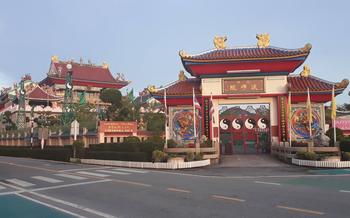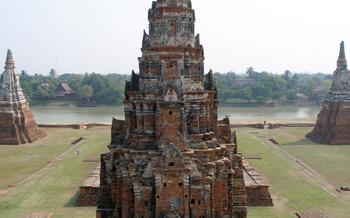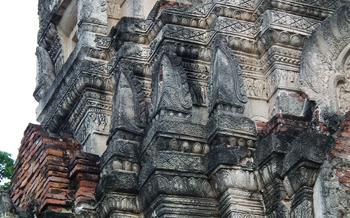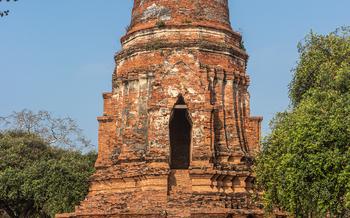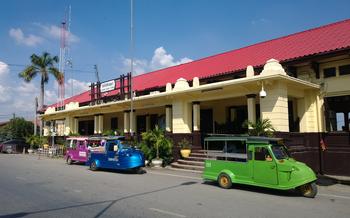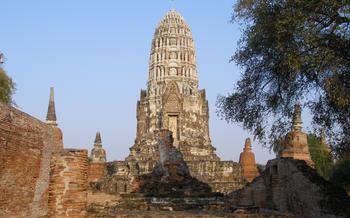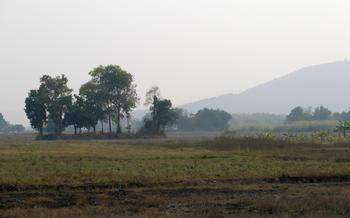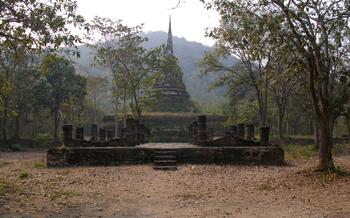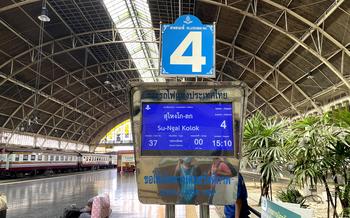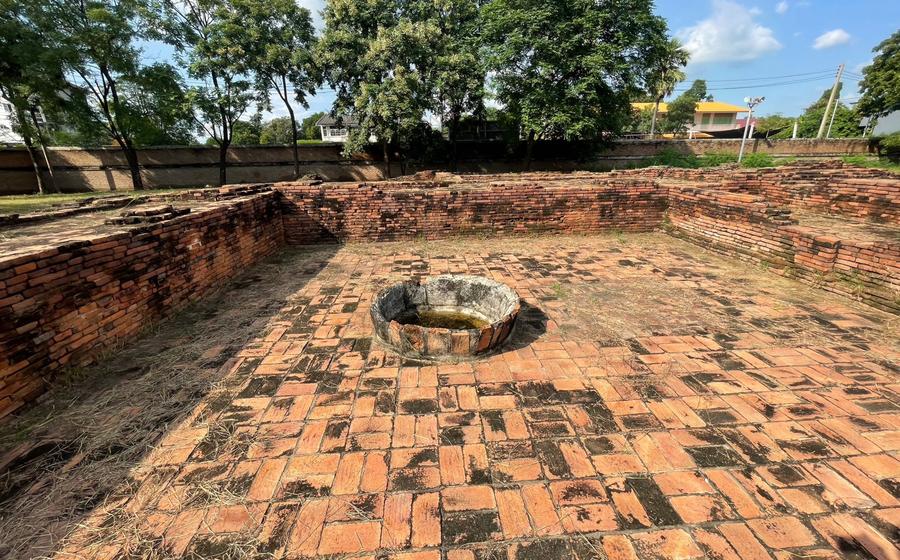
Portuguese Settlement
- Historical Background
- Location and Accessibility
- Main Attractions
- Religious Significance
- Cultural Heritage
- Architecture and Design
- Walking Tour
- Local Cuisine
- Shopping Opportunities
- Off-the-Beaten-Path Sights
- Photography Tips
- Family-Friendly Activities
- Accessibility for Disabled Visitors
- Insider Tip: Unveiling the Hidden Gems of the Portuguese Settlement
Historical Background
Ayutthaya, the former capital of Thailand, boasts a rich and storied past, serving as a prominent trading hub in the 16th century. During this era, the Portuguese, renowned for their maritime prowess, arrived in Ayutthaya, seeking new trade routes and commercial opportunities. Their presence in the city marked a significant chapter in its history, leading to the establishment of a Portuguese settlement that would play a pivotal role in shaping Ayutthaya's cultural tapestry.
The Portuguese community, driven by their entrepreneurial spirit, quickly integrated into Ayutthaya's vibrant society, contributing to its economic growth and cultural exchange. Over time, they established a thriving settlement on the outskirts of the city, becoming an integral part of the cosmopolitan fabric of Ayutthaya. This fusion of cultures resulted in a unique blend of Portuguese and Thai influences, leaving an indelible mark on the city's architecture, cuisine, and traditions.
Location and Accessibility
The Portuguese Settlement is situated within the Ayutthaya Historical Park, a UNESCO World Heritage Site, approximately 80 kilometers northeast of Bangkok, Thailand's capital city. The settlement is conveniently located within the city walls, making it easily accessible by foot or bicycle from other attractions in the historical park. The nearest airport is Don Mueang International Airport, which is about an hour's drive away. Alternatively, visitors can take a train or bus from Bangkok to Ayutthaya, and then a tuk-tuk or taxi to the Portuguese Settlement. Accommodation options are plentiful in Ayutthaya, ranging from budget hostels to luxury resorts, many of which are within walking distance of the Portuguese Settlement.
Main Attractions
The Portuguese Settlement in Ayutthaya is home to several notable attractions that showcase the rich history and cultural heritage of the Portuguese community. The centerpiece of the settlement is the Portuguese church, built in the 17th century. This impressive structure features a distinctive architectural style that blends European and Asian influences. The church's interior is adorned with intricate carvings, paintings, and a grand altar that reflects the Portuguese devotion to Catholicism.
Other notable buildings and structures within the settlement include the Portuguese Governor's Mansion, which served as the administrative center of the Portuguese community, and the Portuguese Hospital, which provided medical care to the Portuguese residents. These buildings offer a glimpse into the daily lives of the Portuguese settlers and their interactions with the local population.
The settlement also houses a museum that showcases a collection of unique artifacts and relics related to the Portuguese presence in Ayutthaya. These include religious objects, trade goods, and personal belongings that provide valuable insights into the cultural exchange and assimilation that took place between the Portuguese and the Siamese.
Historical plaques and information boards are strategically placed throughout the settlement, providing visitors with detailed information about the history, significance, and stories behind each attraction. These informative displays enhance the visitor experience, allowing them to gain a deeper understanding of the Portuguese legacy in Ayutthaya.
Religious Significance
The Portuguese played a pivotal role in spreading Christianity in Ayutthaya, leaving an indelible mark on the city's religious landscape. The Portuguese church, a testament to their faith, stands as a symbol of their missionary zeal. Its architectural features, such as the intricate stained-glass windows depicting biblical scenes, reflect the Catholic influence that permeated the city.
To this day, the church remains an active place of worship, hosting regular religious services and ceremonies. Christian pilgrims and visitors from around the world flock to this sacred site to pay homage and seek spiritual solace. The church's significance extends beyond its religious function; it serves as a reminder of the cultural exchange and assimilation that took place between the Portuguese and the Siamese people.
Cultural Heritage
The Portuguese presence in Ayutthaya left an enduring legacy on the local culture. The Portuguese community, known as the "Luso-Thais," played a pivotal role in introducing new customs, traditions, and culinary delights to the region. Their influence can still be seen in the local cuisine, festivals, language, and even in the physical appearance of some Thai people.
One of the most notable Portuguese influences on Thai cuisine is the introduction of new ingredients and cooking techniques. Dishes like "massaman curry" and "feijoada" are believed to have Portuguese origins, and the use of spices such as chili and garlic became more prevalent in Thai cooking during this period. Portuguese desserts, such as "khanom farang" (a sweet egg custard) and "khanom thok" (a coconut-based sweet dumpling), are still popular in Thailand today.
The Portuguese also introduced several festivals and traditions to Ayutthaya. The annual "Loy Krathong" festival, which involves releasing decorated floats on water, is believed to have originated from a Portuguese tradition. Another festival, known as the "Feast of the Assumption," is celebrated by the local Catholic community and features colorful processions and religious ceremonies.
The Portuguese language also left its mark on the local dialect. Several words in the Thai language, such as "pão" (bread), "sabão" (soap), and "cadeira" (chair), are derived from Portuguese words. The Portuguese influence on the local language can still be heard in the pronunciation of certain words and phrases.
Overall, the Portuguese community in Ayutthaya made significant contributions to the local culture, leaving a lasting legacy that can still be seen and experienced today.
Architecture and Design
The Portuguese settlement in Ayutthaya is a testament to the unique architectural style that the Portuguese brought to Southeast Asia. The buildings are constructed using laterite bricks, which gives them a distinctive reddish-brown color. The walls are adorned with intricate carvings and motifs, showcasing the craftsmanship and artistry of the Portuguese builders.
One of the most striking features of the Portuguese architecture in Ayutthaya is the use of fortified walls and gates. These fortifications were built to protect the settlement from attacks by enemies. The walls are thick and high, with sturdy gates that could be closed to prevent entry. The gates are often decorated with elaborate carvings and sculptures, adding to the overall grandeur of the settlement.
The Portuguese settlement in Ayutthaya is a well-preserved example of Portuguese colonial architecture in Southeast Asia. It is a fascinating place to visit for anyone interested in history, architecture, or culture.
Walking Tour
To fully immerse yourself in the charm of the Portuguese Settlement, embark on a self-guided walking tour. Start at the Portuguese Church, admiring its intricate facade and learning about its history. Proceed to the nearby Domingos House, where you can glimpse the lifestyle of a wealthy Portuguese family. Don't miss the serene atmosphere of Santa Cruz Church, a testament to the area's rich religious heritage.
Along the way, keep an eye out for historical plaques and information boards that provide insights into the settlement's past. Capture Instagram-worthy moments at every corner, framing the ancient laterite walls, quaint alleys, and charming Portuguese-style houses. Take your time to soak in the unique ambiance of this historic enclave, where time seems to stand still. The walking tour typically covers a distance of about 1 kilometer and can be completed at a leisurely pace within an hour or two.
Local Cuisine
The Portuguese influence in Ayutthaya extends beyond architecture and culture, leaving an indelible mark on the local cuisine. Foodies will delight in the diverse culinary offerings that pay homage to the Portuguese heritage.
Sample the delectable Khao Soi with its unique blend of spices and coconut milk, a dish believed to have Portuguese origins. Khanom Pang Sang Kaya, a custard-filled bread, is another must-try, showcasing the Portuguese love for pastries.
For a truly authentic experience, head to the vibrant street food markets. Indulge in mouthwatering Moo Ping, grilled pork skewers marinated in a sweet and savory sauce, or savor the flavors of Pad Prik King, a stir-fried pork dish with bell peppers and Thai chilies.
Don't miss out on the opportunity to take a cooking class or workshop, where you can learn to recreate these Portuguese-inspired dishes in your own kitchen. Discover the secrets of Thai cuisine and bring back a taste of Ayutthaya to your home.
Shopping Opportunities
The Portuguese Settlement in Ayutthaya is a treasure trove for shopping enthusiasts. Local markets offer a vibrant array of souvenirs and handicrafts, from intricate wood carvings and colorful textiles to delicate jewelry and hand-painted ceramics. Don't miss the chance to browse through the stalls and pick up unique items that reflect the Portuguese heritage of the area.
For those seeking Portuguese-inspired goods, specialized shops are scattered throughout the settlement. Here, you can find an assortment of traditional Portuguese clothing, home décor, and culinary delights. From intricate lace dresses to hand-painted tiles, there's something for every taste and budget.
Remember to embrace the local etiquette of bargaining when shopping. Politely negotiate prices with the vendors, but be respectful and fair in your offers. This interaction is not only a way to get a good deal but also a chance to connect with the locals and learn about their culture.
As you explore the markets and shops, keep an eye out for one-of-a-kind items that you won't find anywhere else in Thailand. These unique treasures, infused with Portuguese influence, will serve as lasting mementos of your visit to the Portuguese Settlement.
Off-the-Beaten-Path Sights
Beyond the main attractions, the Portuguese Settlement holds hidden gems and lesser-known spots that offer a glimpse into its rich history and local life. Wander off the beaten path to discover quiet corners for relaxation and contemplation. Engage with locals in authentic conversations and uncover historical anecdotes and stories associated with these hidden places. Immerse yourself in the Portuguese Settlement's unique charm by exploring its hidden treasures.
Photography Tips
Capture the essence of the Portuguese Settlement through your lens with these photography tips:
-
Golden Hours: Time your visit for the magical golden hours, either at sunrise or sunset, when the warm, diffused light casts a golden glow on the ancient structures, creating a picturesque backdrop.
-
Architectural Details: Focus on the intricate details of the Portuguese architecture, from the arched doorways to the delicate carvings and moldings. Experiment with different angles and perspectives to highlight these unique features.
-
Scenic Panoramas: Take advantage of the elevated viewpoints within the settlement to capture sweeping vistas of the surrounding landscape. Capture the interplay of ancient ruins, lush greenery, and the tranquil river in a single frame.
-
Local Life: Capture the vibrant energy of the Portuguese Settlement by photographing the locals going about their daily lives. From street vendors to artisans, each person adds a unique story to the tapestry of this historic neighborhood.
Family-Friendly Activities
Enriching experiences for young minds and hearts
The Portuguese Settlement in Ayutthaya offers a delightful blend of history, culture, and engaging activities that cater to families traveling with children. Step into a world where the past comes alive through interactive experiences and storytelling sessions. Guided tours specially designed for kids unravel the fascinating tales of the Portuguese community, their customs, and their impact on local traditions.
Little explorers can embark on a treasure hunt, following clues that lead them to hidden gems within the settlement. Historical reenactments and performances bring the rich history of the settlement to life, captivating young imaginations. Workshops and hands-on activities allow children to immerse themselves in Portuguese culture, learning about traditional crafts, music, and dance.
The Portuguese Settlement provides a unique opportunity for families to create lasting memories and foster a deep appreciation for diverse cultures. Whether it's exploring the ancient ruins, participating in interactive activities, or simply soaking in the vibrant atmosphere, there's something for everyone to enjoy.
Accessibility for Disabled Visitors
The Portuguese Settlement in Ayutthaya is committed to ensuring an inclusive and accessible experience for visitors with disabilities.
-
Wheelchair accessibility: The settlement's main pathways and buildings are wheelchair accessible, allowing visitors to navigate the site with ease. Ramps are provided at necessary points to eliminate barriers.
-
Designated parking: Visitors with disabilities are allocated designated parking areas close to the settlement's entrance, ensuring convenient access.
-
Transportation assistance: For visitors requiring assistance with transportation, the settlement provides wheelchair-accessible vehicles or collaborates with local transportation providers to arrange suitable options.
-
Accessibility features: Within the settlement, accessible restrooms and seating areas are available for the comfort and convenience of disabled visitors. Handrails and tactile signage are also provided for added support and orientation.
-
Trained staff: The settlement's staff is trained to assist visitors with disabilities, providing guidance, directions, and any necessary assistance throughout their visit.
Insider Tip: Unveiling the Hidden Gems of the Portuguese Settlement
As you embark on your journey through the Portuguese Settlement, keep an eye out for hidden gems that often go unnoticed by the casual visitor. Venture beyond the main attractions and explore the quiet corners and secluded alleys where the true essence of the settlement lies. Discover the hidden chapel, tucked away amidst the lush greenery, where locals gather for prayers and meditation. Climb to the top of the old watchtower for a breathtaking panoramic view of the settlement and the surrounding countryside. And if you're lucky, you might stumble upon a local festival or celebration, where you can immerse yourself in the vibrant Portuguese culture and traditions.
